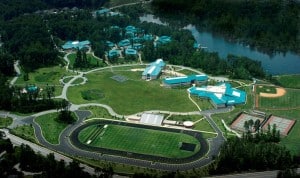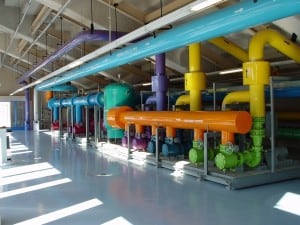This article originally appeared in the summer issue of HaGesher, American Hebrew Academy’s Newsletter. American Hebrew Academy is America’s only Jewish pluralistic college prep boarding school.
By Alina Spaulding, Director of Communications, American Hebrew Academy
 For most athletes “going for the gold” is a personal motivation but at the American Hebrew Academy, students and staff are learning that “going for the green” is equally important. “I know that I can put the catsup and the mustard in the squeezable containers” our mashgiach (kashrut supervisor), Paul, says in his pristine South African accent, as he explains that single use packets of condiments are wasteful… and he is concerned about how the kitchen at the American Hebrew Academy can do its share to stay “green.”
For most athletes “going for the gold” is a personal motivation but at the American Hebrew Academy, students and staff are learning that “going for the green” is equally important. “I know that I can put the catsup and the mustard in the squeezable containers” our mashgiach (kashrut supervisor), Paul, says in his pristine South African accent, as he explains that single use packets of condiments are wasteful… and he is concerned about how the kitchen at the American Hebrew Academy can do its share to stay “green.”
In 2007-08, the kitchen at the country’s only pluralistic Jewish college prep boarding school switched from buying produce from around the globe to using locally grown, and often organic produce. For the Academy, an institution which serves 20 meals per child per week, cost savings, better quality, and reduction in transportation costs were all benefits in “going green.” Furthermore, students, staff, and parents all agreed that the food tastes fresher and the vegetarian options were both creative and delicious.
Some may feel that the American Hebrew Academy’s campus is environmentally friendly “by accident.” Truth be told, there is something that drives the environmental commitment that cannot be quantified. It is the kavanah, or intention, of the founder, Chico Sabbah.
Born in Brooklyn, Sabbah moved to Israel in 1950 following Ben-Gurion‘s dream to make the dessert bloom. He later became an agronomist. When the historic gift was made to start America’s first and only Jewish pluralistic college prep boarding school, Sabbah hired an environmental arborist to identify rare trees and plants throughout the breathtaking campus. He then hired architect Aaron Green (Coincidence? We think not!) to create the campus using organic architecture, a design philosophy conceived by Frank Lloyd Wright in which buildings are integrated into, and become part of, the natural landscape. Green’s design also incorporated many local building materials into the campus design. “Local” for the Academy means North Carolinian products, as well as those that come fromIsrael. The campus’s buildings are clad in Jerusalem stone, providing a physical connection toIsrael, as well as the spiritual one which is only enhanced when students experience a semester in Israel in their junior year.
The campus includes 26 buildings, all built within nature. Each building is crowned with a skylight, also manufactured inIsrael, that allows the influence of natural light, proven to save energy and stimulate emotional well being. Beneath the schools soccer stadium, and running track, which is made of recycled rubber, rests the jewel in the crown of the ecological system at the Academy. Five hundred feet below the campus is the world’s largest closed loop, geothermal heating and cooling system. This $3 million dollar investment including over 950 wells, continuously recycling natural water to heat and cool everything from the kosher dining hall and its refrigeration units to the natitorium. Student houses are heated and cooled each day, but the academic buildings and athletic center “sleep” at night, so energy is conserved while buildings are not in use. The system, which initially cost $2 million more than a traditional heating and cooling system is expected to pay for itself in the next four years, only 12 years since its installation. At which point the Academy will be heating and cooling at an annual costs savings of 40% over conventional methods. As the campus grows with more students, the efficiency of the system will grow as well increasing costs savings to as high as 60%, all with thanks to Mother Nature. And because the geothermal system takes advantage of the earth’s natural temperature as well as recycling all of the water it uses, nothing goes to waste.
The geothermal pumphouse is one of several “living classrooms” on campus. Here, students can learn about geothermal energy and earth science, not to mention be reminded about the Jewish value of tikkun olam, the responsibility of each person to repair the world.
Walking past the kosher concession stand, you will find six greenhouses, housing the Academy’s 147 etrog trees. Between the Academic buildings, sits the “Gardens of Israel” which were designed by the students, and are now in full bloom with grapes, vegetables, and trees that are cared for by students and staff.
It is likely that one of the greatest contributors to the decrease of the “carbon footprint” that the Academy is leaving is that nearly all of the 100 acre campus is restricted to pedestrian traffic. Staff who need to get from place to place at long distances are issued electric vehicles.
The wireless campus, together with laptop and tablet computers, provided to every student and member of the Academy’s faculty act to help save paper, but they also pose one of the greatest challenges when it comes to conservation. The campus network allows students to turn papers in on line, but many teachers continue to require the “standard” ten-page paper, printed, single sided, double-spaced, with 1 ½ inch margins. “As an institution, we want to serve as an example to our students and the Academy is leading the way for all other high schools to follow”, says Glenn Drew, Executive Director of the American Hebrew Academy, “but we still have a very long way to go, particularly in the use of recyclable and biodegradable materials.”
In the meantime, Paul, the mashgiach, continues his search, evaluating the increased cost of switching to compostable utensils and cups versus the energy consumed by dishwashing, or the production of standard paper products that tend to be of lower quality.





No comments yet.